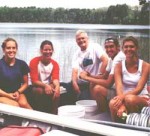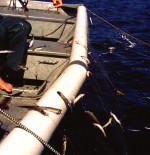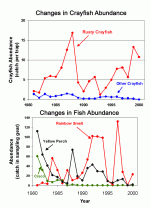Rusty crayfish (Orconectes rusticus) and rainbow smelt (Osmerus mordax) are important invaders of lakes in Northern Wisconsin. Both species have severe impacts on native aquatic flora and fauna. Because invasions often begin with just a few individuals, elimination of invaders from a lake once they become established may seem like a hopeless task. However, if it is possible to attack the invader population at multiple life stages, control may be possible.
One of the core study lakes in the NTL-LTER site, Sparkling Lake, provides an excellent opportunity to perform a whole-lake test of our ability to eliminate invasive populations. Sparkling Lake has populations of both rainbow smelt and rusty crayfish. Two undergraduates from the University of Wisconsin-Madison, Katie Hein and Stacy Lischka, along with a graduate student, Brian Roth, undertook the challenge under the supervision of John Magnuson and other senior investigators. Funding came from a BioComplexity grant, LTER, Tug and Jean Juday Undergraduate Research Scholarship, and the NSF Research Experiences for Undergraduates program.
Smelt, Osmerus mordax
Smelt are native to the north Atlantic coast of the US. Lake Superior is the likely source of Sparkling Lake smelt. The native fish species in Sparkling Lake included cisco (Coregonus artedii) and yellow perch (Perca flavescens). Walleye (Stizostedion vitreum) and smallmouth bass (Micropterus dolomieui) are not native to Sparkling Lake, but they are native to the region. The Wisconsin Department of Natural Resources (WDNR) traditionally stocked Sparkling Lake with walleye. In the 1970s-80s Sparkling Lake was one of the most productive walleye fisheries in Vilas County. Cisco have been extirpated from the Sparkling Lake system since the introduction and proliferation of smelt. Walleye are able to grow to large sizes by eating the abundant smelt, but walleye are not reproducing in Sparkling Lake. Yellow perch are near extirpation.
Effects of smelt
Research conducted at NTL-LTER shows that in Sparkling Lake the smelt introduction caused the cisco population to crash owing to predation. In other lakes, NTL researchers found that smelt outcompete yellow perch for zooplankton prey, and cause yellow perch populations to crash. Larger smelt prey upon smaller smelt, but smelt dynamics are such that they probably will not drive themselves to local extinction through cannibalism.
Smelt Removal
During the summer of 2001 Stacy Lischka, a Juday Fellow at UW Madison, studied the population dynamics of smelt in Sparkling Lake using catch data from the early 1980s to present. She estimated the smelt population using sonar along transects in the lake. Once Stacy had a population estimate, a two-week preliminary trial removal was attempted. The exotics removal team netted 9,383 smelt, removing 21% of the population. A major removal effort will start in spring and summer of this year.
Rusty crayfish, Orconectes rusticus
O. rusticus is native to the central United States, but over the years its range expanded to Northern Wisconsin and two of the NTL-LTER study lakes. O. rusticus were first found in Sparkling Lake in the 1980s. The population probably originated from anglers using them as live bait or introductions to remove macrophytes. These practices were outlawed in the 1983, but for Sparkling Lake it was too late.
Effects of O. rusticus
Rusty crayfish displaced the native crayfish species, O. virilis, and another introduced species, O. propinquus, in Sparkling Lake. Crayfish are voracious omnivores. They destroy macrophyte beds and consume vast quantities of benthic invertebrates. The macrophytes provide habitat and food for invertebrates and prey fishes. O. rusticus therefore compete with prey fishes in addition to destroying a good source of fish habitat. Finally, O. rusticus consume fish eggs, decreasing recruitment of fish.
Crayfish removal
During the summer of 2002, Katie Hein, an undergraduate at UW Madison working under the Research Experiences for Undergraduates program, studied the distribution of O. rusticus in Sparkling Lake using a mark-recapture study along transects at various depths and substrates. These data were used to design an intensive trapping effort in August 2001. During the removal effort, the team removed 11,184 O. rusticus, an estimated 50% of the population.
Future Directions
The substantial removals during a brief period of intensive trapping and netting suggest that heavy mortality can be inflicted on invading species in a relatively short time. During 2002, the removal team will attack the smelt population by netting and increased predation. Smelt spawn in gravel substrate shortly after ice-out, and come ashore in large numbers. The removal team will use fyke nets in the gravel areas of Sparkling Lake to capture the spawning smelt. The goal is to capture as many reproductive smelt as possible and thereby minimize reproduction. Then, during June-August, the removal team will selectively net pre-reproductive smelt every two weeks from June-August with horizontal gill nets.
The state management agency (WDNR) will continue to stock large walleye in the spring of 2002. The WDNR stocked 395 walleye in the 13.5-21.9 mm size class during the spring of 2001. The walleye are considered the "safety net." Researchers expect the walleye to prey on the smelt in the less than 90mm size class. The larger reproductive smelt, greater than 170 mm, will die off with time, or will be heavily impacted by the netting during the spawning period. Between each netting, sonar transects of the lake will track the effectiveness of the removal effort.
As for the crayfish removal, the goal for 2002 is to remove as many of the larger crayfish as possible by intensive trapping throughout the summer. The trapping effort is expected to capture more males than females in the population early on, but over time the removal team expects to catch more females in the traps. The traps favor the larger individuals in the population, between 30-40mm carapace lengths.
To increase predation on crayfish, the WDNR has changed the fishing regulations on Sparkling Lake. Effective this year, minimum walleye catch size limits will increase from 15 to 26 inches. Small mouth bass minimum catch size will increase from 14 to 18 inches. Small mouth bass consume smaller crayfish, less than 25 mm carapace length. A single small mouth bass at 18 inches will consume over 1 Kg of crayfish in a single summer.
This removal effort is a landmark study. No one has attempted whole-lake removal experiments of exotics. The legacy of long-term data at NTL provides a unique opportunity to interpret this removal effort as an experiment in the resilience of an aquatic ecosystem. Will Sparkling Lake return to its pre-invader state after the invaders are removed from the system? Does changing the fish regulations increase predation enough to control prey populations? We expect to test these and related questions over the next few years in Sparkling Lake.

 Enlarge this image
Enlarge this image

